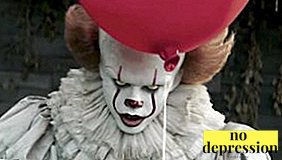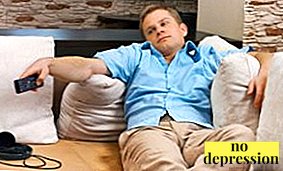Circus for the majority is a colorful celebration with the participation of various disguised characters, including funny clowns.
Here are just some of the children, and adults are beginning to freeze with horror at the same sight. colorful figure with a bright nose and mouth. How does the fear of clowns arise?
Concept of co-lophobic

Uncontrolled and panic fear of clowns is called coolrophobia.
The term is derived from the Greek word "coulro".
So called the participants of the theatrical performance, who wore masks and amused or frightened the audience.
In psychiatry, the attitude towards the term is ambiguous. Some psychiatrists do not consider co-leaf phobia as abnormality and some consider it a serious disease and are seeking treatment regimens.
What is the phobia?
Fear can take many forms - from a slight feeling of discomfort to panic attack. It appears at the sight of a person dressed as a man and increases dramatically if the clown starts to come closer, tries to speak, etc.
Some people think that even if people laugh at clown jokes, it’s actually a nervous laugh.
This phobia began to spread massively at the end of the 20th century. According to online surveys, about 80 out of 100 people are wary of clowns.
Facts about coolrophobia in this video:
Causes

Phobia develops more often in children especially small ones, as they are more emotionally receptive.
But adults of suspicious type are also subject to such fear.
Fear usually arises due to the following reasons:
- A fixed mask or a face covered with makeup does not make it clear what are the true emotions the person under them is experiencing.
- Manners of actors under the bright mask too expressive, sharp movements, loud laughter and often unnatural. Such behavior of an ordinary person can signal mental disorders. And any danger scares.
- Most people are afraid of being ridiculed in public. Clowns can engage viewers in submission even against their will. Discomfort is fixed in the mind.
- Clown can behave unpredictable, and unpredictability frightens.
- Happens allergic reaction on make up. Colerophobia may not appear, but subconscious rejection will arise.
- Little children scares everything new, especially if the unfamiliar character who has come is too bright, talks unnaturally and laughs, tries to touch the baby.
 Not all employees of entertainment agencies that parents hire, for example, on the child's birthday, have the necessary professional skills to communicate with children. Often a phobia occurs after the first visit to the circus.
Not all employees of entertainment agencies that parents hire, for example, on the child's birthday, have the necessary professional skills to communicate with children. Often a phobia occurs after the first visit to the circus. - Psychiatrists believe that they contributed a lot to the spread of coerrophobia and the writers horror movieswhere the main villain and actor was a clown. Having watched such a film, it is easy to mentally finish in your hands a chainsaw or a cleaver to an ordinary clown in a circus.
- Very rarely, but the occurrence of a phobia occurs in a person who has suffered real serious physical or mental trauma man in a jester costume. For example, there was a beating, rape, etc.
Especially often this is subject to adolescents, who are sensitive to the slightest criticism.
Why did coarrophobia in Americans?
In 1990 screen adaptation of Stephen King novel "It". The main character is a clown-maniac killing children.
This character made a particularly strong impression when, according to the laws of the genre, after anxious, disturbing music, he jumped out as if from nowhere and was terribly laughing.
The film was a great success. In a short time, many such horror films appeared.
 In addition, from time to time there were messages in the news about murderers, pedophiles, thieves and simply inadequate people, committing crimes under fun mask.
In addition, from time to time there were messages in the news about murderers, pedophiles, thieves and simply inadequate people, committing crimes under fun mask.
It is not surprising that coralrophobia bloomed in terry color. In the Soviet Union, such horror films, of course, were not produced.
Soviet cartoons and films showed the clown as a sweet, funny and good-natured jester, always ready to help.
Circus Clowns Yuri Nikulin, Oleg Popov, Mikhail Rumyantsev (Pencil), without exaggeration, the whole country knew and loved. Therefore, almost no one heard about clownophobia.
But as soon as a flood of western horror movies rushed, a mass phobia appeared among people, especially children, and in our country.
Symptoms
Appear usually at the news that a person will see a clown, for example, will go on a circus show. Arises anxiety, excitement, may start a headache.
Signs of

Arise when a person sees a clown:
- sharp increase in pressure;
- pallor, trembling, numbness of the limbs;
- tachycardia;
- chest pain;
- lack of air, choking;
- dry mouth;
- dizziness;
- faint or faint;
- increased sweating;
- temperature rise;
- nausea, vomiting;
- lump in the throat;
- fear of death, a sense of unreality. The world around us is perceived as in slow motion;
- loss of control over behavior, affect state.
Children usually start screaming, crying and trying to hide. Adults they try to run away or rush to the cause of horror with their fists, start throwing various objects at the clown, pour obscene language.
Subsequently, a person often cannot even remember what exactly he did. At such moments he was guided by the instinct of self-preservation and animal fear, and he did not realize his actions.
Such attacks usually last from several minutes to half an hour. When you eliminate the object of concern, they pass by themselves. There is a feeling of depression and weakness.
Signs can also occur in cases where a person has seen a clown in a dream. But since 90% of sleep is forgotten within 10 minutes after waking up, the signs are not so pronounced and pass faster.
Why is the child afraid of a clown? Find out from the video:
Coping methods

It would seem that, the easiest - Do not go to the circus, do not watch movies and programs with clowns.
But the risk of encountering them in real life is great.
Often on city streets, in kindergartens festive events are organized, advertising actions with the participation of these characters. Frequent panic attacks deplete the nervous system. This condition requires treatment.
Psychotherapy
With a child often works "Dress up game".
Fear recedes if the baby sees that there is a well-known person under the makeup.
You can dress in a clown costume in the presence of a baby, suggest painting a face together. You can offer a child most dress up as a clown and perform in front of family or your friends with a funny number.
Show baby good cartoons, where the clown really helps those in trouble, makes fun funny numbers. If you want to go with the child to the circus, make sure that the program is designed for viewers of any age.
With adults should deal psychotherapist. In conversation, he will find out the causes of co-lophobia and help take measures to overcome fear. The patient can view photos, videos with clowns. Then he may be offered to face face-to-face fear.
In advanced cases it is applied to adults and children. hypnosis. In a state of trance, people are told that there is nothing dangerous in the comic characters.
Pharmacology

If the phobia turns into depression or neurosis, need medical support.
To prescribe any drugs should only psychiatrist. It can be:
- tranquilizers - Diazepam, Dormicum, Fenazepam and others;
- antidepressants - Pyrazidol, Prozac, Tsipramil, Anafranil, etc .;
- nootropic drugs - Pyritinol, Mexidol, etc.
The doctor may advise drugs and teas possessing light soothing effect - with mint, valerian, motherwort, chamomile, etc.
Other recommendations
I'm afraid of clowns: what to do? When confronted with a source of fear, if a panic attack does not develop rapidly, such tricks will help:
- To breathe so that the exhalation is a little longer than the inhale.
- Exhale into a packet of paper or in the palm, folded in a boat.
- Massaging earlobes, little fingers.
- To inspire yourself that a clown is not dangerous, it’s just a disguised artist.
Rememberthat coolrophobia is fairly easy to treat. Do not hesitate and in running cases, contact your doctor. 3-5 sessions are usually sufficient for a good specialist.

 Not all employees of entertainment agencies that parents hire, for example, on the child's birthday, have the necessary professional skills to communicate with children. Often a phobia occurs after the first visit to the circus.
Not all employees of entertainment agencies that parents hire, for example, on the child's birthday, have the necessary professional skills to communicate with children. Often a phobia occurs after the first visit to the circus.

